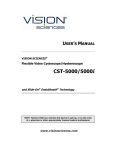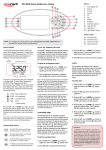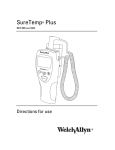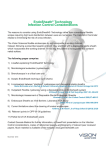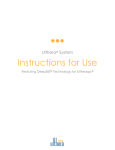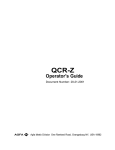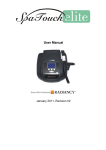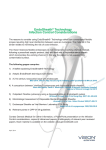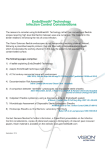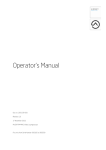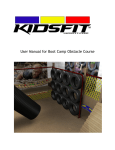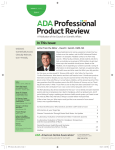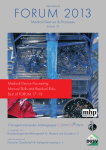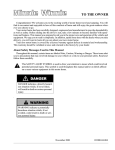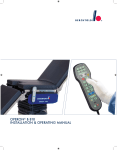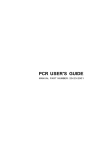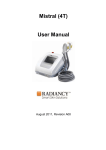Download ENT-4000/4500
Transcript
USER’S MANUAL VISION SCIENCES® Flexible Nasopharyngo-Laryngoscope ENT-4000/4500 NOTE: Federal (USA) law restricts this device to sale by, or on the order of, a physician or other appropriately licensed medical professional. www.visionsciences.com ©2009, 2012 Vision-Sciences, Inc. All rights reserved. Printed in the United States of America. The information contained herein is the exclusive and confidential property of Vision-Sciences, Inc. No part of this manual may be disclosed or reproduced in whole or in part without permission from Vision-Sciences, Inc. How to Use This Manual This User’s Manual contains the recommended procedures for preparing and using the Vision Sciences® ENT-4000/4500 Flexible Nasopharyngo-Laryngoscope. It is intended for physicians and other medical personnel who will come in contact with the endoscope before, during, and after any patient procedures performed with it. The manual also contains pertinent information on the proper care and handling of the endoscope. Please read and become familiar with this entire manual before using the endoscope. This manual contains the following information: Description of the endoscope The endoscope’s intended use Components and features of the endoscope and peripheral equipment used in conjunction with the endoscope Complete instructions on endoscope preparation, inspection, operation, reprocessing, and storage Warning and Caution statements that must be observed by endoscope users to ensure patient and user safety If you are a first time endoscope user, Vision-Sciences, Inc. strongly recommends that you read this manual from beginning to end and become intimately familiar with the endoscope and its use. If you are an experienced endoscope user, select specific chapters and/or sections that pertain to features and procedures that you are using. _______________________________________________________________________ Organization of this Manual Following is a list of the chapters included in this manual. Each chapter’s title is listed at the top of all pages after the title page, so that you can quickly access the information you need. Chapter 1, Symbols and Terms – This chapter defines the symbols on the endoscope and peripheral equipment. There is also a brief list of the terms that are commonly used in the manual. Chapter 2, Important Information – The information in this chapter is a summary of critical Warning and Caution statements in the manual. This information is essential to the safe operation and reprocessing of the endoscope. Vision-Sciences, Inc. strongly recommends that this chapter be read thoroughly and completely understood by all users before working with the endoscope. Chapter 3, Endoscope and Accessories – Introduces the ENT-4000/4500 Flexible Nasopharyngo-Laryngoscope and compatible peripheral equipment. This chapter includes instrument diagrams, identifies components, and defines their functions. ENT-4000/4500 Flexible Nasopharyngo-Laryngoscope User’s Manual i How to Use This Manual Chapter 4, Preparation, Inspection and Operation – This chapter describes how to prepare the endoscope and peripheral equipment for use, and the assembly of the equipment into a system. The chapter also leads you through a detailed inspection procedure to confirm that the equipment is undamaged and working properly before it is used in a procedure. Chapter 5, Reprocessing – This chapter contains important instructions on the proper cleaning, disinfection, and sterilization of the endoscope before its first use and after each subsequent use. Strict adherence to the instructions in this chapter will render the endoscope “patient-ready” for each procedure. Chapter 6, Care and Storage – If the equipment will not be used for a prolonged period, refer to this chapter for instructions on safe, secure storage. Chapter 7, Troubleshooting – Describes possible problems that may be encountered with the endoscopic system, and suggests corrective actions to take towards resolving minor problems. Chapter 8, Warranty and Service – This chapter contains the terms of the Vision Sciences warranty on the endoscope, any restrictions that apply and user actions that may void the warranty if taken. This chapter also includes shipping instructions in case the endoscope must be returned to Vision-Sciences, Inc. for repair or service. The Appendix contains the technical specifications for the ENT-4000/4500 Nasopharyngo-Laryngoscope, and infection control information. Additional Information The information in this User’s Manual is subject to change without notice. If you have any questions regarding any of the material contained in this manual, or wish to confirm that this is the most comprehensive information available for these products, please contact your local distributor or Vision-Sciences Customer Service Department at (800) 874-9975 or (+1) 845-359-0276 (International). ii ENT-4000/4500 Flexible Nasopharyngo-Laryngoscope User’s Manual Table of Contents How to Use This Manual ................................................................................... i Organization of this Manual ..................................................................................... i Additional Information ........................................................................................... ii 1 Symbols and Terms................................................................................... 1 Symbols ................................................................................................................ 1 Terms ................................................................................................................... 1 2 Important Information ............................................................................. 3 Intended Use ........................................................................................................ 3 User Qualifications ................................................................................................. 3 Reprocessing ......................................................................................................... 3 Maintenance and Repair ......................................................................................... 4 Signal Words ......................................................................................................... 4 Important Safety Precautions ................................................................................. 4 Preparation, Inspection and Assembly………………………………………………………………… 4 During Use……………………………………………………………………………………………………….. 5 Reprocessing……………………………………………………………………………………………………. 6 3 Endoscope and Accessories ...................................................................... 7 Inspect the Standard Set........................................................................................ 8 Equipment Diagrams .............................................................................................. 9 ENT-4000/4500 Flexible Nasopharyngo-Laryngoscope………………………………………….. 9 Accessories ......................................................................................................... 12 Light Sources………………………………………………………………………………………………….. 12 BLS-1000 Battery Powered Light Source……………………………………………………………. 12 Light Guide Cables…………………………………………………………………………………………… 12 Add-On Camera System…………………………………………………………………………………… 12 Leak Testing…………………………………………………………………………………………………… 12 Reprocessing………………………………………………………………………………………………….. 12 Light Source Adapters (Light Guide Sleeves)……………………………………………………… 13 4 Preparation, Inspection and Operation .................................................. 15 Preparation and Inspection................................................................................... 16 Endoscope Operation with BLS-1000 Battery Powered Light Source ........................ 16 Endoscope Operation – Other Light Source ........................................................... 18 5 Reprocessing .......................................................................................... 19 ENT-4000/4500 Flexible Nasopharyngo-Laryngoscope User’s Manual iii Table of Contents Reprocessing Steps .............................................................................................. 20 Leak Testing ........................................................................................................ 20 Attach the Leak Tester to the Endoscope………………………………………………………….. 21 Leak Test Connection Components……………………………………………………………………. 21 Pressurize the Endoscope………………………………………………………………………………… 21 Cleaning/Disinfection/Sterilization ......................................................................... 23 Cleaning and Intermediate Level Disinfection After Slide-On® Endo-Sheath® Technology Use……………………………………………………………………………………… 23 High-Level Disinfection and Sterilization ................................................................ 24 Recommended High Level Disinfection and Sterilization Procedures…………………….. 24 Incompatible Methods .......................................................................................... 25 High-Level Disinfection Protocol……………………………………………………………………….. 26 Cleaning………………………………………………………………………………………………………… 26 High-Level Disinfection……………………………………………………………………………………. 26 Rinsing………………………………………………………………………………………………………….. 26 Ethylene Oxide (EtO) Gas Sterilization………………………………………………………………. 27 STERRAD® and STERIS® Sterilization………………………………………………………………... 28 6 Care and Storage .................................................................................... 29 Storage ............................................................................................................... 29 Disposal .............................................................................................................. 29 7 Troubleshooting ...................................................................................... 31 8 Warranty and Service ............................................................................. 35 Warranty Information........................................................................................... 35 Vision-Sciences Service Information ...................................................................... 35 Shipping to Vision-Sciences, Inc. ........................................................................... 36 Appendix........................................................................................................ 37 Specifications ...................................................................................................... 37 Infection Control Information ............................................................................... 38 iv ENT-4000/4500 Flexible Nasopharyngo-Laryngoscope User’s Manual Table of Contents Index of Figures Figure Figure Figure Figure Figure 3-1: 3-2: 3-3: 5-1: 5-2: ENT-4000/4500 Nasopharyngo-Laryngoscope ................................................... 9 ENT-4000/4500 Nasopharyngo-Laryngoscope (Control Body) ...................... 10 Light Source Adapters (Light Guide Sleeves) .................................................. 13 Leak Tester Connection ...................................................................................... 21 Opening the Vent Valve ...................................................................................... 23 Index of Tables Table Table Table Table 3-1: ENT-4000/4500 Nasopharyngo-Laryngoscope Standard Sets ....................... 8 5-1: STERRAD® and STERIS® Validated Systems/Cycles .................................. 28 7-1: Troubleshooting ..................................................................................... 32 A-1: Specifications ......................................................................................... 37 ENT-4000/4500 Flexible Nasopharyngo-Laryngoscope User’s Manual v 1 Symbols and Terms Symbols The symbols listed below can be found on the ENT-4000/4500 Flexible Nasopharyngo-Laryngoscope and on other components of the endoscopic system. Type BF applied part 1(Safety degree specified by IEC 60601-1). Alerts the user to the presence of important operating, maintenance, and service instructions. Refer to and become familiar with the user’s manuals for all equipment used in the procedure. Serial number of the endoscope Equipment bearing this mark has been designed, tested, and certified as essentially compliant with all applicable European Union (EU) regulations and recommendations. Up position for the angulation lever Down position for the angulation lever Underwriters Laboratories Component Recognition Mark STERIS® and STERRAD® Reprocessing Compatibility Refer to Chapter 5, Reprocessing (Endoscope must feature the S symbol for compatibility to apply) ○ Terms The following terms are used throughout this User’s Manual: “Laryngoscope”, “Endoscope”, or “ENT Scope” - Refers to the Vision Sciences® ENT-4000/4500 Nasopharyngo-Laryngoscope. “Sheath” – Refers to the disposable ENT Slide-On® EndoSheath® Technology for the ENT-4000/4500 Nasopharyngo-Laryngoscope. ENT-4000/4500 Flexible Nasopharyngo-Laryngoscope User’s Manual 1 2 Important Information The information in this chapter is essential for the correct and safe operation of the ENT-4000/4500 Flexible Nasopharyngo-Laryngoscope. Please read and understand this information before preparing or using the endoscope or any peripheral equipment with which it will be used. Intended Use The Vision Sciences® ENT-4000/4500 Flexible Nasopharyngo-Laryngoscope is intended to be used for flexible endoscopic examination of the upper airway, vocal cords and/or nasal passages. NOTE: The ENT-4000/4500 is not intended for electrosurgical procedures. Do not use the endoscope for any purpose other than these intended uses. User Qualifications This equipment should only be used in a medical facility by or under the supervision of a physician trained in laryngoscopy. Only use the endoscope and peripheral equipment according to the instructions and under the operating conditions described in this manual. Failure to do so could result in compromised safety, equipment malfunction and/or instrument damage. For preparation of the device before use, and disassembly and proper cleaning after use, users should be adequately trained in the proper procedures. Failure to thoroughly understand these details, such as – but not limited to – EndoSheath® Technology installation and authorized disinfection protocols, may pose an infection-control risk and/or cause equipment damage. If training assistance is desired from either the manufacturer or a local distributor, please contact Vision-Sciences Customer Service at (800) 874-9975 or (+1) (845) 359-0276. Reprocessing The endoscope must be thoroughly cleaned, disinfected, and/or sterilized before its first use and after each subsequent use. This is the only way to ensure that a “patient-ready” endoscope is used in every procedure. See Chapter 5, Reprocessing, for information on reprocessing equipment and procedures. ENT-4000/4500 Flexible Nasopharyngo-Laryngoscope User’s Manual 3 Important Information Maintenance and Repair The endoscope contains no user-serviceable parts; never attempt to modify or repair it. Doing so may cause further equipment damage and/or compromise patient safety if the endoscope is subsequently used in a procedure. The endoscope may only be serviced / repaired at an authorized Vision-Sciences, Inc. facility. The endoscope should be thoroughly inspected before each procedure and should be periodically inspected to determine if there is damage or wear that requires attention. Signal Words Information included in this manual to warn users of the possibility of patient injury and/or equipment damage is signified by the Warning and Caution symbols below. Warnings, Cautions and Notes will appear throughout this manual; carefully read and follow all statements. Alerts the user to situations which, if not avoided, could result in death or serious injury. Alerts the user to situations which, if not avoided, could result in moderate or minor injury to the user or patient. It is also used to alert the user to conditions and actions that could cause equipment damage. NOTE: Indicates additional helpful information. Important Safety Precautions The following precautions should always be exercised when using the endoscope and all medical equipment to ensure safety to all involved parties – user(s), patient(s), etc. They are summarized here in the order of the stages of the endoscope’s use. Preparation, Inspection and Assembly Carefully inspect all equipment before using it in a procedure, and do not use any equipment that is damaged or excessively worn. Doing so could lead to patient injury and/or further damage to the equipment. If inspection reveals difficulty in articulation of the endoscope’s Distal Bending Section, the endoscope may be damaged. Do not use the endoscope in this case. Contact your local distributor or call the Vision-Sciences Customer Service Department. 4 ENT-4000/4500 Flexible Nasopharyngo-Laryngoscope User’s Manual Important Information All devices that are connected to the ENT-4000/4500 Flexible Nasopharyngo-Laryngoscope must be Classified Medical Equipment. Before using any additional equipment confirm that it complies with the appropriate end-product safety standard (such as IEC 60950-1) and the Standards for Medical Electrical Equipment, UL 60601-1 or IEC 60601-1. Never drop the equipment or subject it to severe impact, as it could compromise the functionality and/or safety of the equipment or system. Should the equipment be mishandled or dropped, do not use it. Immediately return it to an authorized Vision-Sciences service facility for inspection and repair. NOTE: The Vision Sciences® ENT-4000 and ENT-4500 Flexible Nasopharyngo-Laryngoscopes and Slide-On® EndoSheath® Technology are latex-free products. During Use Do not use this equipment in the presence of a flammable anesthetic mixture containing air, oxygen or nitrous oxide. There is a possibility of fire or explosion. The ENT-4000/4500 is not intended to be used with electrosurgical devices. If any of the component of the endoscopic system malfunction during the procedure, or if the endoscopic image is lost or compromised, immediately move the endoscope’s Distal Bending Section into the neutral position and slowly withdraw the endoscope from the patient. Using an endoscope that is not functioning properly could cause patient injury and/or further damage to the equipment. Always wear appropriate personal protective equipment when using the endoscope and/or sheath, such as a gown, gloves, and face and eye shields. Avoid excessive bending or twisting of the endoscope’s Insertion Tube. Although they are designed to bend, excessive bending can damage the fiber bundles and internal components. Should the endoscope develop a severe kink or bend, do not attempt to straighten the Insertion Tube. Contact Vision-Sciences Customer Service for assistance. DO NOT apply excessive pressure to the Angulation Lever, as it could damage the endoscope and lead to patient injury. DO NOT look directly at the intense light emitted from the endoscope tip to avoid the possibility of eye injury. ENT-4000/4500 Flexible Nasopharyngo-Laryngoscope User’s Manual 5 Important Information Reprocessing The endoscope must be properly reprocessed, by cleaning, disinfection and/or sterilization, before its first use and after each subsequent use. Using an endoscope in a procedure that has not been properly reprocessed presents an acute infection-control risk to both the patient and medical personnel performing or assisting in the procedure. Always wear appropriate personal protective equipment when reprocessing the endoscope, such as a gown, gloves, and face and eye shields. Use extreme care when reprocessing the endoscope. Do not forcefully pull, push, or drag wipes, towels, or cloths along the Insertion Tube. The use of excessive force could damage the endoscope. DO NOT immerse the endoscope in disinfectant solution for long periods of time (in excess of 1 hour). Prolonged immersions may damage the outer coverings of the endoscope and allow fluid infiltration. DO NOT place the endoscope in or near contaminated areas after it has been reprocessed. Doing so can re-contaminate the endoscope and require reprocessing to be repeated. DO NOT place the endoscope in awkward or confining areas between procedures as this could result in equipment damage. 6 ENT-4000/4500 Flexible Nasopharyngo-Laryngoscope User’s Manual 3 Endoscope and Accessories The Vision Sciences® ENT-4000/4500 Flexible Nasopharyngo-Laryngoscopes are designed to perform safe, sterile, and efficient endoscopy. This equipment has been designed for the examination of the upper airway from the nasal passages to the vocal cords, including the larynx. With proper use, the endoscope provides a thorough examination for more accurate diagnoses with minimal patient discomfort. The ENT-4000/4500 Flexible Nasopharyngo-Laryngoscope is shown in Figures 3-1 and 3-2 on pages 9 and 10. The endoscope does not have a working channel; it contains three fiberoptic light bundles and a fiberoptic image bundle. The ENT-4000/4500 Flexible Nasopharyngo-Laryngoscopes are validated for use with the Slide-On® EndoSheath® Technology. The ENT-4000/4500 endoscopes can be used with or without the Slide-On® EndoSheath® Technology. The sterile, disposable Sheaths are installed over the endoscope’s Insertion Tube, acting as a protective barrier to protect patients and users from the spread of potentially pathogenic materials. Be sure to handle the endoscope with care during use, reprocessing and storage. The fiberoptics are comprised of thin glass fibers which can be damaged by physical trauma, extreme temperatures, high humidity, or fluid invasion of the endoscope. ENT-4000/4500 Flexible Nasopharyngo-Laryngoscope User’s Manual 7 Endoscope and Accessories Inspect the Standard Set Do not use any equipment that is observed to be damaged or excessively worn. Doing so could lead to patient injury and/or further damage to the equipment. When the endoscope is received from Vision-Sciences, Inc., immediately confirm that the items listed in Table 3-1 below have been shipped, and inspect them for damage. If any item is missing or damaged, do not use the endoscope. Contact Vision-Sciences, Inc. to obtain a replacement part. ENT-4000 NASOPHARYNGO-LARYNGOSCOPE STANDARD SET CATALOG NO. DESCRIPTION 02-4202 ENT-4000 Endoscope 07-3060 Light Guide Cable, 1.8m 07-6015 Vent Cap 07-6180 Vision Sciences® ENT-4000/4500 Carrying Case ENT-4000/4500 User’s Manual (this document) ENT-4500 NASOPHARYNGO-LARYNGOSCOPE STANDARD SET 02-4502 ENT-4500 Endoscope 07-3060 Light Guide Cable, 1.8m 07-6015 Vent Cap 07-6180 Vision Sciences® ENT-4000/4500 Carrying Case ENT-4000/4500 User’s Manual (this document) OPTIONAL ITEMS AND ACCESSORIES (NOT SHIPPED WITH ENDOSCOPE) 07-6160 Installation Stand, Floor Model 07-6161 Installation Stand, Clamp Model 07-6162 Installation Stand, Wall Mount 07-6010 Endoscope Leak Tester 07-3050 Light Guide Sleeve Adapter BLS-1000 Battery Powered Light Source Set (with Batteries and Battery Charger) BLS-1000 Battery Powered Light Source (Replacement) 07-3058* BLS-1000 Battery Charger (Replacement) 07-3059 BLS-1000 Batteries (2 Batteries) (Replacement) See List on Page 13 07-3053* Table 3-1: ENT-4000/4500 Nasopharyngo-Laryngoscope Standard Sets *Contact distributor for region-specific configuration 8 ENT-4000/4500 Flexible Nasopharyngo-Laryngoscope User’s Manual Endoscope and Accessories Equipment Diagrams ENT-4000/4500 Flexible Nasopharyngo-Laryngoscope Figure 3-1: ENT-4000/4500 Nasopharyngo-Laryngoscope ENT-4000/4500 Flexible Nasopharyngo-Laryngoscope User’s Manual 9 Endoscope and Accessories ENT-4000/4500 Flexible Nasopharyngo-Laryngoscope Figure 3-2: ENT-4000/4500 Nasopharyngo-Laryngoscope (Control Body) Endoscope and Control Body: 1. Angulation Lever: This integral component of the Control Body controls the endoscope’s Distal Tip deflection. 2. Light Guide Cable Connector (Light Post): One end of the Detachable Light Guide Cable is inserted into the external Light Source to allow light to be projected to the endoscope’s Distal Tip. The other end of the Cable is attached to this Connector on the Control Body. 3. Eyepiece/Ocular: Located at the top of the Control Body, this feature allows the user to view the image directly. Alternatively, a standard video camera, still photography system, or teaching attachment can be connected to the eyepiece, allowing the image to be displayed on a video monitor and/or photographed. 10 ENT-4000/4500 Flexible Nasopharyngo-Laryngoscope User’s Manual Endoscope and Accessories 4. EndoSheath® Interface: Located at the base of the Control Body, this component secures the disposable Slide-On® EndoSheath® Technology to the endoscope. 5. Identification Ring: Includes the Serial Number, which is a unique number identifying the endoscope; and the ○ S symbol, which indicates the endoscope can be sterilized using a validated STERIS® or STERRAD® system. The endoscope must feature this symbol on the ID ring in order for STERIS® or STERRAD® compatibility to apply. Also includes a UL symbol (Underwriters Laboratories), which indicates the fiberscope is recognized as a component that can be used in tandem with add-on components such as light sources and camera attachments. 6. Vent Valve: When the Vent Cap is connected here, this Valve allows access to the interior of the endoscope for EtO or STERRAD® Gas Sterilization, and should be connected during transport. The Vent Cap must be attached to this Valve prior to EtO or STERRAD® Gas Sterilization and prior to shipping. The valve is also used as a Leak Tester Connector for Leak Testing. 7. Distal Bending Section: Deflects up and down when the Angulation Lever is actuated by the user. 8. Distal Tip: The terminating point of the image fiber bundle [Objective Lens] and the light guide fiber bundles [Light Guides]. 9. Control Body: This segment allows physician control over endoscopic functions. 10. Insertion Tube: This component, along with the Distal Tip, is the part of the endoscope that is inserted into the patient. 11. Diopter Adjustment Ring: Located on the Control Body, this ring turns clockwise or counterclockwise to adjust the image until the image is clear. When a video camera, still photography systems, or teaching attachment is used, the white dot on the control body should be aligned with the white dot on the Diopter Adjustment Ring. When using an add-on camera, use the Focus Ring on the camera to adjust focus, instead of the Diopter Adjustment Ring. Not Shown in Diagram: Detachable Light Guide Cable: Standard 1.8m cable shipped with endoscope. Light Guide Sleeve: Adapts the Light Guide Cable to make it compatible with different light sources. ENT-4000/4500 Flexible Nasopharyngo-Laryngoscope User’s Manual 11 Endoscope and Accessories Accessories Do not use any accessories that are not in compliance with the equivalent safety requirements of this equipment. Doing so may reduce the operational safety of the system and could cause patient and/or user injury. For all accessories, confirm that the safety certifications have been performed in accordance with the appropriate standard (IEC 60601-1 and/or IEC 60601-1-1). Use of accessories not specified in this manual or sold by Vision-Sciences, Inc. may result in increased electromagnetic emissions or decreased immunity of the equipment or system. Light Sources BLS-1000 Battery Powered Light Source An LED light source that allows for endoscopic illumination without a light guide cable. Refer to Chapter 4, Preparation, Inspection and Operation for proper set-up and operation information. The ENT-4000/4500 Endoscope is designed to be used with the BLS-1000 Battery Powered Light Source. Light Guide Cables Additionally, the ENT-4000/4500 Endoscope is designed to be compatible with various light sources when using the detachable Light Guide Cable. To ensure proper mating with the selected light source, be sure that the appropriate Light Guide Sleeve is securely threaded onto the Light Guide Cable. Refer to Figure 3-3 for a complete list and diagrams of the available Light Guide Sleeves. Add-On Camera System The ENT-4000/4500 Endoscope features a “rigid” style eyepiece compatible with most manufacturers’ Add-On Camera Systems. Ensure that the Camera System’s coupler is designed for a “rigid” style eyepiece. If it is not, please contact Vision-Sciences, Inc. for compatibility assistance. Leak Testing The ENT-4000/4500 Endoscope may only be leak tested with a Vision Sciences® Endoscope Leak Tester. Reprocessing The ENT-4000/4500 Endoscope may be reprocessed by a variety of methods. Refer to Chapter 5, Reprocessing for the accessories that will be used when reprocessing the endoscope. Contact Vision-Sciences Customer Service for advice on compatibility issues. 12 ENT-4000/4500 Flexible Nasopharyngo-Laryngoscope User’s Manual Endoscope and Accessories Light Source Adapters (Light Guide Sleeves) The following Light Guide Sleeves are available to adapt Vision Sciences® endoscopes for use with other manufacturers’ light sources when using a Detachable Light Guide Cable. Using an incorrect or incompatible adapter could result in impaired operation and viewing, and could cause damage to the endoscope, light guide cable and/or light source. LIGHT GUIDE SLEEVE DIAGRAM CATALOG NUMBER & COMPATIBLE LIGHT SOURCES 06-6019: Vision Sciences® HLS-1500 / XLS-3000, Circon and ACMI Light Sources 06-6009: Vision Sciences® LS-150 and Pentax Light Sources 06-6044: Olympus Light Sources 06-6020: Smith & Nephew, Gyrus, and Richard Wolf Light Sources 06-6029: Machida Light Sources 06-6023: Karl Storz Light Sources Figure 3-3: Light Source Adapters (Light Guide Sleeves) ENT-4000/4500 Flexible Nasopharyngo-Laryngoscope User’s Manual 13 4 Preparation, Inspection and Operation If an abnormality is detected during endoscope preparation, do not use the endoscope. Refer to the tables in Chapter 7, Troubleshooting. If the problem cannot be solved using the information in that chapter, contact your regional distributor or Vision-Sciences Customer Service. Refer to Vision-Sciences Service Information (Chapter 8, Warranty and Service) in this manual. When using the Slide-On® EndoSheath® Technology with the endoscope, refer to the Instructions for Use that are shipped with the system. These instructions will provide complete details on preparing, installing and removing the disposable Sheath. The Slide-On® EndoSheath® Technology is shipped sterile and intended for a single use only. Do not reuse it. When the procedure is complete, remove the sheath from the endoscope and dispose of it. Reusing the sheath can damage it, and in turn cause endoscope damage. In addition, a reused sheath presents a marked infection-control risk to the next patient. If you are not using the Slide-On® EndoSheath® Technology, ensure that the endoscope has undergone the appropriate disinfection process. Refer to Chapter 5, Reprocessing, for compatible reprocessing methods and procedures. Avoid excessive bending or twisting of the endoscope’s insertion tube, particularly at the distal end. While the tube is designed to bend, excessive pressure can damage the fiber bundles and internal components. Excessive angulation or excessive pressure placed on the Angulation Lever may cause equipment damage. Do not exert force to move the lever beyond its natural limits. During the procedure, the temperature at the distal end of the endoscope may exceed 41oC (106 oF) due to intense endoscopic illumination. Surface temperatures over 41oC (106 oF) may cause mucosal burns. Always use the minimum level of illumination necessary for adequate viewing. Whenever possible, avoid close stationary viewing and do not leave the distal end of the endoscope in close proximity to mucous membranes for a long period of time. If using the Slide-On® EndoSheath® Technology and image glare is present, lower light source intensity until glare disappears. ENT-4000/4500 Flexible Nasopharyngo-Laryngoscope User’s Manual 15 Preparation, Inspection and Operation Preparation and Inspection Follow the inspection steps listed below before connecting any equipment or using the system. Do not use the equipment if abnormalities are present. 1. Check the Insertion Tube for holes, superficial cuts, or abrasions. 2. Lightly run your fingertips over the entire length of the Insertion Tube to confirm that it is smooth and does not exhibit looseness or bagging. Do not apply excessive pressure to the endoscope’s Insertion Tube. Doing so can damage the internal components. 3. Check for full Distal Tip deflection by actuating the Angulation Lever up and down. Avoid applying excessive pressure when using the Angulation Lever. Doing so could damage the angulation mechanism. 4. Clean the Lens on the endoscope’s Distal Tip with an alcohol prep pad. Do not use abrasive materials to clean the Lens. Doing so could damage the Lens and impair the endoscope’s imaging capability. 5. Ensure that the proper Light Guide Adapter is securely connected to the Light Guide Cable. 6. Securely insert the Light Guide Cable into the light source. 7. Look through the Eyepiece and rotate the Diopter Adjustment Ring until the fiber pattern is clearly focused. 8. When using a video camera, still photography system, or teaching attachment with the endoscope, make sure that the white dot on the Control Body is aligned with the white dot on the Diopter Adjustment Ring. Endoscope Operation with BLS-1000 Battery Powered Light Source 16 1. Prior to use, the BLS-1000 should be reprocessed. Please refer to the BLS1000 Battery Powered Light Source User’s Manual for proper Reprocessing procedures and compatibilities. 2. If necessary, insert charged or new batteries into the BLS-1000. 3. Verify the BLS-1000 is in proper working condition before attaching to the endoscope by examining the outer cover for damage, secure cover fit, and, with Light Source powered OFF, verify that the window over the bulb is clear and not obstructed. 4. Thread the BLS-1000 onto the endoscope Light Post. Verify that the Light Source is OFF until needed. ENT-4000/4500 Flexible Nasopharyngo-Laryngoscope User’s Manual Preparation, Inspection and Operation 5. Just prior to the procedure, rotate the outer body of the BLS-1000 to the ON position. Point the light-emitting area of the Light Source away from eyes before turning on the light. 6. Verify light emission by viewing through the eyepiece. While viewing through the eyepiece, rotate the Diopter Adjustment Ring clockwise or counterclockwise until the fiber pattern in the image field is clearly focused. Do not handle the BLS-1000 with contaminated gloves. If the BLS-1000 becomes contaminated, it must be reprocessed per the protocols in the BLS-1000 Battery Powered Light Source User’s Manual. Avoid excessive bending or twisting of the endoscope’s insertion tube, particularly at the distal end. While the tube is designed to bend, excessive pressure can damage the fiber bundles and internal components. 7. Hold the endoscope so that the control body fits comfortably in your hand, allowing easy manipulation of the Angulation Lever. The other hand is free to manipulate the Insertion Tube of the endoscope. Excessive angulation or excessive pressure on the Angulation lever may cause equipment damage. Do not exert force to move the lever beyond its natural limits. 8. Prepare the patient using normally acceptable clinical practice prior to endoscope insertion. 9. Lubricate the outside of the endoscope (or Sheath, if used) before inserting the endoscope into the patient. Vision-Sciences, Inc. recommends that the endoscope (or Sheath, if used) be lubricated with water or a water-based lubricant just prior to insertion. 10. Introduce the endoscope into the patient using normally acceptable clinical practice. Operate the Angulation Lever as necessary for advancement and observation. 11. Upon completion of the procedure, withdraw the endoscope under direct visualization without holding the Angulation Lever. This will allow the Distal Bending Section to move freely during withdrawal. 12. When the procedure is finished, rotate the outer body of the BLS-1000 to the OFF position, and confirm that the light is off. ENT-4000/4500 Flexible Nasopharyngo-Laryngoscope User’s Manual 17 Preparation, Inspection and Operation Endoscope Operation – Other Light Source 1. Connect the Light Guide Cable to the endoscope. 2. Secure the appropriate Light Guide Sleeve to the cable. 3. Connect Light Guide Cable to the Light Source. 4. Hold the endoscope so that the Control Body fits comfortably in your hand, allowing you to manipulate the Angulation Lever. The other hand is free to manipulate the Insertion Tube. 5. Turn the light source on. Adjust the brightness to the desired level using the light source’s brightness adjustment controls. 6. Prepare the patient, using normally acceptable clinical practice prior to endoscope insertion. 7. If the endoscope will be inserted into the patient’s mouth, first place a bite block into the patient’s mouth to prevent bite damage. 8. Lubricate the outside of the endoscope (or Sheath, if used) before inserting the endoscope into the patient. Vision-Sciences, Inc. recommends that the endoscope (or Sheath, if used) be lubricated with water or a water-based lubricant just prior to insertion. 9. Introduce the endoscope into the patient using normally acceptable clinical practice. Operate the Angulation Lever as necessary for advancement and observation. 10. When the procedure is completed, withdraw the endoscope under direct visualization without holding the Angulation Lever. This will allow the Distal Bending Section to move freely during withdrawal. 18 ENT-4000/4500 Flexible Nasopharyngo-Laryngoscope User’s Manual 5 Reprocessing The ENT-4000/4500 Flexible Nasopharyngo-Laryngoscope can be used either with or without the Slide-On® EndoSheath® Technology*. Vision-Sciences, Inc. recommends the use of the Slide-On® EndoSheath® Technology; a sterile disposable protective covering which limits the need for elaborate chemical disinfection or sterilization procedures after every endoscopy procedure. The complete system enables the user to implement a fast and effective method of reprocessing an endoscope, and benefits both user and patient by providing an Insertion Tube covered with a sterile Sheath for every procedure. For cleaning and disinfection procedures when using the Slide-On® EndoSheath® Technology, see Cleaning After Slide-On® EndoSheath® Technology Use on page 23. The endoscope must be properly reprocessed by cleaning, disinfection and/or sterilization, before its first use and after each subsequent use according to the protocols in this section. Using an endoscope in a procedure that has not been properly reprocessed presents an acute infection-control risk to both the patient and medical personnel performing or assisting in the procedure. Some methods of disinfection and sterilization may be harmful to the endoscope and exposure to them could result in extensive equipment damage. Please contact Vision-Sciences, Inc. Customer Service to verify the compatibility of a cleaning method not listed in this manual and/or a complete list of functionally compatible agents. Clean the endoscope immediately after use in a procedure. Failure to do so may allow patient debris to harden on the endoscope’s external surfaces, which can become difficult to remove and could inhibit subsequent disinfection/sterilization processes. Do not use an endoscope that has been determined to have a leak, and do not immerse such an endoscope in any fluids. Fluid entry into the endoscope can cause equipment damage and render the endoscope unfit for patient use. Always wear appropriate personal protective equipment when reprocessing the endoscope or any of its components. Appropriate protective equipment includes items such as a gown, gloves, and face and eye shields. Complete and thorough reprocessing of the endoscope is the only way to ensure that a “patient-ready” endoscope is used in all patient procedures. Closely adhere to the reprocessing instructions given in this chapter. *Vision Sciences® Slide-On® EndoSheath® products for ENT endoscopes are covered by the following U.S. patents: 6,350,231; 6,530,881; 6,733,440. These products may be covered by other U.S. or international patents. ENT-4000/4500 Flexible Nasopharyngo-Laryngoscope User’s Manual 19 Reprocessing Reprocessing Steps The endoscope reprocessing procedure is made up of a series of steps, each of which is essential to successful reprocessing. Note: The ENT-4000/4500 endoscope may only be leak tested with a Vision Sciences® Endoscope Leak Tester. Leak Testing – The reprocessing procedure requires exposing the endoscope’s surface to and immersing the endoscope itself in fluids. If there is a leak in any part of the endoscope, the internal components of the endoscope are vulnerable and will likely be damaged by fluid invasion. Before cleaning, disinfecting and/or sterilizing the endoscope, it is essential to perform a leak test to ensure the interior of the endoscope is resistant to fluid invasion. Cleaning – Visible debris is removed from the surface of the endoscope in this procedure, which uses water and an instrument-grade detergent. When the Slide-On® EndoSheath® Technology is used and inspection after the procedure confirms that the Sheath was not compromised, surface cleaning and intermediate level disinfection of the endoscope is sufficient to prepare it for the next procedure. Intermediate-Level Disinfection – After use with EndoSheath® Technology and proper cleaning, the endoscope should undergo intermediatelevel disinfection. For the complete routine, see Cleaning After Slide-On® EndoSheath® Technology Use on page 23. For procedures without utilizing the EndoSheath® Technology, intermediate-level disinfection is not an adequate level of reprocessing. High-Level Disinfection – For procedures where the endoscope comes in direct contact with the patient, or following any procedure during which the user suspects the endoscope became contaminated, it is necessary to immerse the endoscope in a high-level disinfectant. Sterilization is also recommended. See the High-Level Disinfection Protocol and Sterilization section in this chapter. Sterilization – In addition to high-level disinfection, the endoscope may be sterilized using ethylene oxide (EtO) gas. Following sterilization, the endoscope must be thoroughly aerated to ensure that all EtO gas residues have been removed. The endoscope may also be sterilized using a validated STERRAD® or STERIS® system. Refer to the STERRAD®/STERIS® section in this chapter. Endoscope must feature the S symbol for STERRAD® / STERIS® compatibility. ○ Leak Testing The ENT-4000/4500 Flexible Nasopharyngo-Laryngoscope must be evaluated for possible leaks in the Control Body and/or the Insertion Tube before immersion in any fluids. The Leak Tester accessory should be used for this test. (Vision Sciences® Leak Tester is required.) Follow the steps given in this chapter. 20 ENT-4000/4500 Flexible Nasopharyngo-Laryngoscope User’s Manual Reprocessing It is essential that gloves be worn when performing the leak test procedure, in case the endoscope’s Insertion Tube has been contaminated and requires further disinfection or sterilization. An endoscope in this condition can present an infection-control risk to the person(s) reprocessing the endoscope. Attach the Leak Tester to the Endoscope Connect the Leak Tester to the endoscope’s Vent Valve (see Figure 5-1). Align the slot on the Leak Tester’s connector with the pin on the Vent Valve, then push down and rotate the connector clockwise until it locks. Figure 5-1: Leak Tester Connection Leak Test Connection Components 1. Connector 2. Vent Valve 3. Alignment Pin (align with slot in Connector) Pressurize the Endoscope 1. Make sure that the Leak Tester’s Pressure-Relief Valve is closed by moving the button to the “out” position. 2. Pump the hand bulb of the Leak Tester until the pressure gauge’s needle reaches the green zone. Due to the size of the internal space of the endoscope, 2-3 pumps of the hand bulb may be required to pressurize the entire chamber. After the first pump, the needle may drop out of the green zone and reach a stable position in the white zone. Continue with additional pumps until the needle no longer falls back into the white zone. ENT-4000/4500 Flexible Nasopharyngo-Laryngoscope User’s Manual 21 Reprocessing Do not over-pressurize the interior of the endoscope (do not allow the needle to go above the green area on the gauge). Over-pressurizing the interior of the endoscope can lead to damage to the endoscope. 3. Maintain the pressure for ten (10) seconds, observing the position of the needle on the pressure gauge. If the pressure decreases, the Leak Tester/endoscope connection may be loose or the Pressure-Relief Valve on the Leak Tester may still be open and should be closed. In this case, remove and reattach the Leak Tester and repeat Steps 1-3. If the pressure decreases after the connections are restored, the endoscope has a damaged seal. Do not continue to use the endoscope or immerse it in fluids in this condition. Contact your regional distributor or the Vision-Sciences Customer Service Center to arrange for evaluation and/or repair. When returning the endoscope, follow the instructions given in Chapter 8, Warranty and Service. 4. If the needle’s position remains steady on the Leak Tester, immerse the entire endoscope in water, and observe it for thirty (30) seconds. Angulate the Distal Bending Section up and down while the endoscope is immersed, as holes in the soft covering of the Distal Bending Section may not be evident while it is in a neutral position. 5. A steady stream of air bubbles at a given location indicates a small leak in the endoscope that was not detected by the pressure gauge. If a leak is detected, the air pressure in the endoscope will prevent water from entering through the leak. However, immediately remove the endoscope from the water and do not immerse it in any more fluids. Do not continue to use an endoscope if leaks are detected. Contact your local distributor or the Vision-Sciences Customer Service Center to arrange for evaluation and/or repair. When returning the endoscope, follow the instructions given in Chapter 8, Warranty and Service. NOTE: Do not mistake the release of trapped air from the crevices on the endoscope's outer surface for a leak. Trapped air can be released by tapping the endoscope gently after immersing it in water. 6. The absence of air bubbles confirms that the endoscope is watertight. Remove it from the water and open the Leak Tester’s Valve. 7. Make sure that the needle on the pressure gauge falls to zero (0), and disconnect the Leak Tester from the endoscope. The endoscope can now be safely immersed in cleaning solutions. Failure to discharge/depressurize the endoscope after leak testing may place stress on the soft covering of the Insertion Tube, potentially producing a “rolling over” of the rubber. 22 ENT-4000/4500 Flexible Nasopharyngo-Laryngoscope User’s Manual Reprocessing Cleaning/Disinfection/Sterilization Use of the Vent Cap The Vent Cap is to be attached to the endoscope prior to all of the following procedures in order to prevent damage caused by changes in pressure and temperature: 1. Gas Sterilization 2. Aeration 3. Shipping Remove the Vent Cap from the endoscope before the following: 1. Patient Use 2. Immersion in Fluids FAILURE TO COMPLY WITH THE ABOVE MAY RESULT IN DAMAGE TO THE ENDOSCOPE AND MAY VOID THE PRODUCT WARRANTY. Figure 5-2: Opening the Vent Valve Cleaning and Intermediate Level Disinfection After Slide-On® EndoSheath® Technology Use The Slide-On® EndoSheath® Technology is intended for a single use only; do not reuse it. When the procedure is complete, remove the Sheath from the endoscope and dispose of it. Reusing the Sheath can present an acute infection-control risk to the user and the next patient on whom the endoscope is used. After a procedure in which the Slide-On® EndoSheath® Technology was used, Vision-Sciences, Inc. recommends performing the following prophylactic cleaning and intermediate disinfection routine between endoscopic procedures: ENT-4000/4500 Flexible Nasopharyngo-Laryngoscope User’s Manual 23 Reprocessing Because of the possibility that a sheath could be torn, or that the endoscope or sheath could come in contact with contaminated surfaces, the user should exercise care when handling the endoscope, whether sheathed or unsheathed. 1. After removing the Sheath, inspect the Insertion Tube and Distal Bending Section, and confirm that these areas are dry. If moisture is observed, there may have been a leak into the Sheath during the procedure, providing the endoscope was dry when the Sheath was attached. In this case, the endoscope must be high-level disinfected and/or sterilized following the instructions given in this chapter. 2. For Cleaning - Gently wash all external surfaces of the endoscope with an appropriate instrument-grade detergent. An ample size basin must be used for cleaning the endoscope. If the basin is too small, the endoscope may inadvertently be kinked or damaged during cleaning. 3. After washing, thoroughly rinse the outside of the endoscope with clean, lukewarm water and place it on a clean, dry surface. 4. For Intermediate-Level Disinfection - Wipe down the entire endoscope with a soft, lint-free cloth or gauze soaked in 70% ethyl or isopropyl alcohol. 5. Ensure that all external surfaces of the endoscope are thoroughly dried prior to attaching another Sheath or storing the endoscope. High-Level Disinfection and Sterilization In the event that the endoscope is contaminated, it should be high-level disinfected or sterilized after cleaning. Use caution when cleaning and then high-level disinfecting or sterilizing the endoscope. Recommended High Level Disinfection and Sterilization Procedures The following procedures have been determined by Vision-Sciences, Inc. to be compatible with the ENT-4000/4500 Flexible Nasopharyngo-Laryngoscope: High-Level Disinfection in Glutaraldehyde: All Vision Sciences® endoscopes are validated for high-level disinfection in 2.4% glutaraldehyde solutions. Perform the High-Level Disinfection Protocol described in this chapter. Sterilization by Ethylene Oxide (EtO) Gas: The endoscope may be sterilized using a validated EtO protocol. The acceptable processing parameters and procedures are given in the Ethylene Oxide (EtO) Gas Sterilization section on page 27. Sterilization by STERRAD®: The endoscope may be sterilized using a validated STERRAD® protocol. Refer to Table 5-1 on page 28 for the approved systems / cycles suitable for use with this endoscope. Sterilization by STERIS®: The endoscope may be sterilized using a validated STERIS® protocol. Refer to Table 5-1 on page 28 for the approved system suitable for use with this endoscope. 24 ENT-4000/4500 Flexible Nasopharyngo-Laryngoscope User’s Manual Reprocessing Disinfection and sterilization methods not listed here may be harmful to the endoscope and exposure could result in extensive damage. Please contact Vision-Sciences Customer Service to determine the compatibility of a disinfection or sterilization method not listed in this manual, and/or a complete list of functionally compatible agents. Acceptable Reprocessing Materials Cleaning Soft Material Lint-Free Gauze (4x4) Enzymatic Cleaner Instrument Grade Detergent Intermediate Level Disinfection 70% Isopropyl Alcohol or 70% Ethyl Alcohol High Level Disinfection 2.4% Glutaraldehyde-based solution Sterilization EtO Gas Sterilization STERRAD® 100S, NX, 100NX* STERIS® System 1E* * Endoscope must feature the ○ S symbol for STERRAD® / STERIS® compatibility Incompatible Methods The high-level disinfection and sterilization chemicals and methods shown below are NOT compatible with the ENT-4000/4500 Nasopharyngo-Laryngoscope; DO NOT USE THEM, as they could cause extensive damage to the endoscope. If you have any questions regarding the compatibility of a given disinfection or sterilization method, please contact your local distributor, representative, or the Vision-Sciences Customer Service Center. Incompatible High Level Disinfection and Sterilization Methods/Chemicals High Level Disinfection Chemicals DO NOT USE Chlorines Formaldehyde Iodophors Sterilization Methods DO NOT USE Autoclave Ultrasonic ENT-4000/4500 Flexible Nasopharyngo-Laryngoscope User’s Manual 25 Reprocessing High-Level Disinfection Protocol If the endoscope was determined to be free of leaks, it may be immersed in a glutaraldehyde solution for the amount of time recommended by the disinfectant manufacturer to achieve high-level disinfection. It is imperative that the endoscope be leak tested and cleaned prior to immersion in high-level disinfectant. Failure to do so may not detect leaks that could allow fluid ingress and damage the endoscope. Failure to clean the endoscope may allow gross debris to remain on external surfaces, which could impair proper disinfection. If the endoscope fails the Leak Test, do not immerse it in fluids and do not use the endoscope in a procedure. Contact Vision-Sciences Customer Service to arrange for repair and/or service of the endoscope. Cleaning 1. Gently pat down the Insertion Tube and wipe the Distal Bending Section with a soft, lint-free cloth or gauze (4x4) to remove visible debris. 2. Perform the Leak Test procedure. 3. Gently wash down all external surfaces with an enzymatic cleaning solution and soak the endoscope in the enzymatic cleaning solution for the time recommended by the enzymatic solution’s manufacturer. 4. Remove the endoscope from the cleaning solution and rinse it thoroughly with clean, lukewarm water. 5. Dry all external surfaces of the endoscope. High-Level Disinfection 1. Immerse the endoscope in the disinfectant solution at the temperature recommended by the disinfectant manufacturer. 2. Allow the endoscope to remain immersed in the disinfectant solution for the period of time recommended by the disinfectant manufacturer. 3. Following disinfection, remove the endoscope from the solution. Rinsing 1. Immerse the endoscope in a container of clean, lukewarm water. 2. Thoroughly rinse the outside of the endoscope with clean, lukewarm water and place it on a clean, dry surface. 3. Wipe all external surfaces of the endoscope with a soft, lint-free cloth or gauze (4x4) until it is completely dry. 4. Confirm that the Lens at the endoscope’s Distal Tip is free of disinfectant residue. 26 ENT-4000/4500 Flexible Nasopharyngo-Laryngoscope User’s Manual Reprocessing Ethylene Oxide (EtO) Gas Sterilization The ENT-4000/4500 Nasopharyngo-Laryngoscope may be sterilized using a validated ethylene oxide (EtO) gas sterilization protocol, following the processing parameters given below. If the Vent Valve is not opened during gas sterilization, the increased heat and pressure from the sterilization process will cause pressure to build up inside the endoscope and could rupture the watertight seals and softer materials of the endoscope. EtO Gas Sterilization Parameters Temperature: 125o 5oF (52oC 3oC) Humidity: 50 10% Exposure Time: 3 hours + 1/-0 hour EtO Concentration: 600 mg/liter Post-Sterilization Aeration: 12 hours at 130oF (55oC) or 72 hours at 75oF (24oC) NOTE: EtO gas sterilization at the above parameters has been validated by Vision-Sciences, Inc. and will sterilize the device to a sterility assurance level (SAL) of 10-6. Prior to EtO Gas Sterilization, the endoscope must be leak tested and completely cleaned and dried according to the High-Level Disinfection Protocol. Failure to properly clean the endoscope may inhibit the EtO Gas Sterilization process. Prior to Gas Sterilization, the Vent Valve must be opened (as shown in Figure 5-2 on page 23) to accommodate the heat and pressure changes of the sterilization process. To open the Valve, press the red Vent cap onto the Vent Valve of the endoscope, and rotate it clockwise until it is seated and locked. After EtO Gas Sterilization: Effective aeration must be completed after EtO gas sterilization. Vision-Sciences, Inc. recommends following the instructions for use supplied by the manufacturer of the gas sterilizer and that a biological indicator be used to confirm effective sterilization. ENT-4000/4500 Flexible Nasopharyngo-Laryngoscope User’s Manual 27 Reprocessing STERRAD® and STERIS® Sterilization Prior to STERRAD® and STERIS® Sterilization, the endoscope must be leak tested, cleaned and dried as described in this chapter. Refer to the STERRAD® or STERIS® Sterilization User’s Manual for complete details on instructions for use. Failure to properly clean the endoscope may inhibit the STERRAD® or STERIS® sterilization process. The Vent Cap must be attached for the STERRAD® sterilization process. The Vent Cap must be removed for the STERIS® sterilization process. STERRAD® and STERIS® sterilization compatibility applies only to endoscopes which feature the S symbol on the Control Body. ○ The ENT-4000/4500 Flexible Nasopharyngo-Laryngoscope has been validated for material and functional compatibility with the following sterilization systems/cycles: STERRAD® 100S Short and Long Cycles STERRAD® NX Short and Long Cycles STERRAD® 100NX Flex Cycle Only STERIS® System 1E Table 5-1: STERRAD® and STERIS® Validated Systems/Cycles 28 ENT-4000/4500 Flexible Nasopharyngo-Laryngoscope User’s Manual 6 Care and Storage Follow the instructions in this chapter if you anticipate that the endoscope will not be used for a prolonged period of time. Do not leave the endoscope exposed to the elements in such circumstances. Storage Follow the instructions below when storing the ENT-4000/4500 Flexible Nasopharyngo-Laryngoscope: DO NOT store the endoscope with Slide-On® EndoSheath® Technology installed on the Insertion Tube. Over time, the Sheath material may adhere to the Insertion Tube and become difficult to remove. When storing the endoscope, be sure to keep the Insertion Tube as straight as possible. The equipment should be completely clean and dry before storing. The endoscope should be maintained in a clean condition during storage so that it is ready for subsequent use. The endoscope should be stored in a dry, well ventilated environment – avoid high humidity, direct sunlight, and temperatures below -10oC or above 60oC. Do not store the endoscope in its carrying case. This case is only intended for endoscope transport; it is not properly ventilated for storage. Avoid storing the endoscope in heavily trafficked areas where there is a chance that it may sustain physical damage. The endoscope should NEVER be stored in areas where it could be exposed to liquids or environmental conditions such as high temperature, humidity, direct sunlight, dust, salt, etc., which could adversely affect its operation. The endoscope should NEVER be stored in the presence of flammable or explosive gases or chemicals. Disposal The equipment should be returned to Vision-Sciences, Inc. for disposal. Contact your local Vision-Sciences representative or service facility for further information. ENT-4000/4500 Flexible Nasopharyngo-Laryngoscope User’s Manual 29 7 Troubleshooting The information in this chapter is intended to help users diagnose problems that may occur during operation of the endoscope. The following tables include some of the problems that could arise during operation, possible causes for those problems, and suggested corrective actions. If the problem persists even after the corrective action has been taken, or a problem occurs that is not covered in the tables, do not use the endoscope. Contact Vision-Sciences, Inc. for repair and/or service using the information given in Chapter 8, Warranty and Service. ENT-4000/4500 Flexible Nasopharyngo-Laryngoscope User’s Manual 31 Troubleshooting PROBLEM PROBABLE CAUSE SUGGESTED ACTION Angulation feels stiff Damaged Distal Bending Section causing impaired angulation. Return the endoscope to VisionSciences, Inc. for repair. Refer to Chapter 8, Warranty and Service. Angulation alignment is no longer up/down Insertion Tube has become twisted. Return the endoscope to VisionSciences, Inc. for repair. Refer to Chapter 8, Warranty and Service. Loss of angulation Angulation wires have been stretched or broken during use. Return the endoscope to VisionSciences, Inc. for repair. Refer to Chapter 8, Warranty and Service. Cloudy or foggy images when the endoscope is unsheathed Patient debris or other material on the Objective Lens. Clean the Objective Lens with an alcohol prep pad to remove material or stain. Excess staining may not be correctable and the lens may require replacement. Fluid incursion into the endoscope’s optical system. Return the endoscope to VisionSciences, Inc. for repair. Refer to Chapter 8, Warranty and Service. The Lens at the Distal Tip has become damaged. Return the endoscope to VisionSciences, Inc. for repair. Refer to Chapter 8, Warranty and Service. Patient material or other substance on the Light Guides. Clean the Distal Tip with an alcohol prep pad to remove material or stain. Excess staining may not be correctable and the lens may require replacement. Light Intensity is set too low. Adjust Light Intensity setting. Damaged light guide fiber bundles. Return the endoscope to VisionSciences, Inc. for repair. Refer to Chapter 8, Warranty and Service. Loss of illumination Table 7-1: Troubleshooting 32 ENT-4000/4500 Flexible Nasopharyngo-Laryngoscope User’s Manual Troubleshooting PROBLEM PROBABLE CAUSE SUGGESTED ACTION Wrinkles and/or folds in the Insertion Tube These may be a result of excessive force applied to the Insertion Tube during cleaning or Sheath removal, or the long-term effects of repeated immersion in chemical disinfecting solutions, which could stretch and weaken the outer coverings. Return the endoscope to Vision-Sciences, Inc. for repair. Refer to Chapter 8, Warranty and Service. Insertion tube is dented Dents can be caused by physical trauma to the endoscope [e.g., closing the case on the Insertion Tube]. Return the endoscope to Vision-Sciences, Inc. for repair. Refer to Chapter 8, Warranty and Service. The Leak Tester is not connected properly to the Vent Valve. Re-connect the Leak Tester and perform the test again. The Leak Tester’s Pressure-Relief Valve is open. Close the Pressure-Relief Valve. A hole or crack has broken the endoscope’s watertight seal. Return the endoscope to Vision-Sciences, Inc. for repair. Refer to Chapter 8, Warranty and Service. Loss of pressure during leak test ENT-4000/4500 Flexible Nasopharyngo-Laryngoscope User’s Manual 33 8 Warranty and Service Warranty Information NOTE: Alterations or repairs done by persons not authorized by VisionSciences, Inc. will void this warranty. Vision-Sciences, Inc. is not liable for any damages to the ENT4000/4500 Flexible Nasopharyngo-Laryngoscope resulting from misuse, negligence, or improper cleaning or storage. The warranty defined herein shall apply only to the original buyer. In no event shall Vision-Sciences, Inc. be liable for anticipated profits, consequential damages or loss of time incurred by the buyer with the purchase or use of this equipment. NOTE: Vision-Sciences, Inc. sells many of its products through regional distributors. Before sending equipment to Vision-Sciences, Inc., contact your regional distributor for repair/return procedures. Vision-Sciences, Inc. warrants that the ENT-4000/4500 Flexible NasopharyngoLaryngoscope and its accessories will be free from defects in materials and workmanship for a period of one year from the date of the invoice. Replacement parts are warranted for a period of ninety (90) days from the date of the invoice. All non-warranty repairs will be warranted to be free from defects in materials and workmanship for a period of ninety (90) days from the date of the invoice. Upon receipt of the ENT-4000/4500 Flexible Nasopharyngo-Laryngoscope for repair, Vision-Sciences, Inc. will evaluate the instrument and make the final decision as to the warranty status. The above warranties are in lieu of all other warranties, either expressed or implied, including warranties of fitness or merchantability. Vision-Sciences Service Information ENT-4000/4500 Flexible Nasopharyngo-Laryngoscopes are serviced at the VisionSciences facility in Orangeburg, New York. Use the following procedure to expedite returned goods for repair or replacement: 1. Telephone your Regional Distributor, Territory Manager, or Vision-Sciences Customer Service (Monday through Friday from 8:00 AM to 5:00 PM EST): USA customers call 1-800-874-9975 International customers call (+1) 845-359-0276 2. Provide a detailed description of the problem. ENT-4000/4500 Flexible Nasopharyngo-Laryngoscope User’s Manual 35 Warranty and Service 3. If troubleshooting cannot solve the problem, a Returned Goods Authorization (RGA) number will be issued. 4. Complete an Incident Report Form and send it to Vision-Sciences, Inc. along with the returned goods. Returned merchandise will only be accepted with an RGA number. Shipping to Vision-Sciences, Inc. If the ENT-4000/4500 Flexible Nasopharyngo-Laryngoscope has been used in a clinical setting, disinfect all system components before shipping as described in Chapter 5, Reprocessing. Shipping contaminated equipment could present an acute infection-control risk for those handling the endoscope, both during shipping and at Vision-Sciences, Inc. If the ENT-4000/4500 Flexible Nasopharyngo-Laryngoscope has been used in a clinical setting but cannot be disinfected before shipping, place a red biohazard label on the shipping container to indicate that the contents are contaminated, in accordance with OSHA standards 29 CFR 1910.1030. Observe the following precautions before shipping the endoscope to VisionSciences, Inc.: 1. Attach the Vent Cap to the endoscope’s Vent Valve in preparation for shipping. 2. If the endoscope has a leak or tear or fails the leak test, or for some other reason cannot be disinfected properly as described in Chapter 5, Reprocessing, wipe the endoscope down with 70% alcohol to remove debris. Indicate on the outer package that the contents are contaminated. 3. Ship the endoscope to Vision-Sciences, Inc. in its carrying case. Place the carrying case inside a corrugated box containing protective shipping material to prevent damage during shipment. Regardless of warranty status, all shipping charges to and from an authorized Vision-Sciences, Inc. facility are the responsibility of the customer. Ship the endoscope to the following address: Vision-Sciences, Inc. 40 Ramland Road South Orangeburg, NY 10962 USA RGA #:____________ NOTE: The customer will be contacted and advised of the estimated repair costs. Repairs will not begin on any equipment until authorization or a purchase order has been issued indicating approval of the charges. 36 ENT-4000/4500 Flexible Nasopharyngo-Laryngoscope User’s Manual Appendix Specifications ENT-4000/4500 Distal Tip Diameter ENT-4000 ENT-4500 3.35 mm 2.40 mm Insertion Tube Diameter ENT-4000 ENT-4500 3.45 mm 2.4 mm 300 mm ENT-4000 ENT-4500 90˚ 80˚ Insertion Tube Working Length Field of View Direction of View 0° Depth of Field 3 - 50 mm Environmental Effects on Optical Performance None Maximum Angulation 140° up/down Operating Environment Temperature 50° to 104° F (10° to 40° C) Relative Humidity 30 to 85% Air Pressure Storage Environment Temperature 700 to 1060 hPa 14° to 140° F (-10° to +60° C) Relative Humidity 0 to 95% Air Pressure Mode of Operation 700 to 1060 hPa Continuous Electrical Safety IEC 60601-1 IEC 60601-2-18 IEC 60601-1 IEC 60601-2-18 Type BF (Body Floating) Thermal Safety Degree of Protection Against Electrical Shock Degree of Protection Against Fluid Invasion IPX7: Fully Immersible (per Reprocessing Instructions) Table A-1: Specifications ENT-4000/4500 Flexible Nasopharyngo-Laryngoscope User’s Manual 37 Appendix Infection Control Information The ENT-4000/4500 Flexible Nasopharyngo-Laryngoscopes are validated for use with the Slide-On® EndoSheath® Technology. This equipment is designed to offer practitioners the ability to perform safe, efficient endoscopy. The Slide-On® EndoSheath® Technology has been proven to be an effective barrier to micro-organisms as small as 27 nanometers1. Efficacy testing for barrier qualities has been performed by an independent laboratory per FDA required guidelines2. All Slide-On® EndoSheath® units undergo a rigorous Quality Assurance process to ensure the utmost in product quality and efficacy. Please contact Vision-Sciences Customer Service for a detailed information packet regarding Infection Control and the Slide-On® EndoSheath® Technology. 1 2 Viral challenge testing performed with bacteriophage 27 nanometers in size, per FDA guidance. Per FDA Clearance requirements, barriers must be tested by the guidelines set within the “FDA Guidance for Manufacturers Seeking Marketing Clearance of … Endoscope Sheaths Used as Protective Barriers” 38 ENT-4000/4500 Flexible Nasopharyngo-Laryngoscope User’s Manual Vision-Sciences, Inc. 40 Ramland Road South Orangeburg, NY 10962 USA Phone: (845) 359-0276 or 800-874-9975 International: (+1)(845) 359-0276 Fax: (845) 365-0620 E-Mail: [email protected] www.visionsciences.com For additional product information or questions pertaining to sales and service, please contact the local distributor or the manufacturer. MedPass International Ltd. Windsor House, Barnett Way Barnwood, Gloucester GL43RT, United Kingdom 0843 © 2009, 2012 Vision-Sciences, Inc. Vision Sciences, EndoSheath and Slide-On are registered trademarks of Vision-Sciences, Inc. 12/12 11759-EN Rev. E (22412)
















































